A guide to jute, sisal, and seagrass natural fiber flat-weave rugs. How the fibers differ and rug care. Plus shopping links to my favorite picks!
Natural Fiber Flat-Weave Rugs
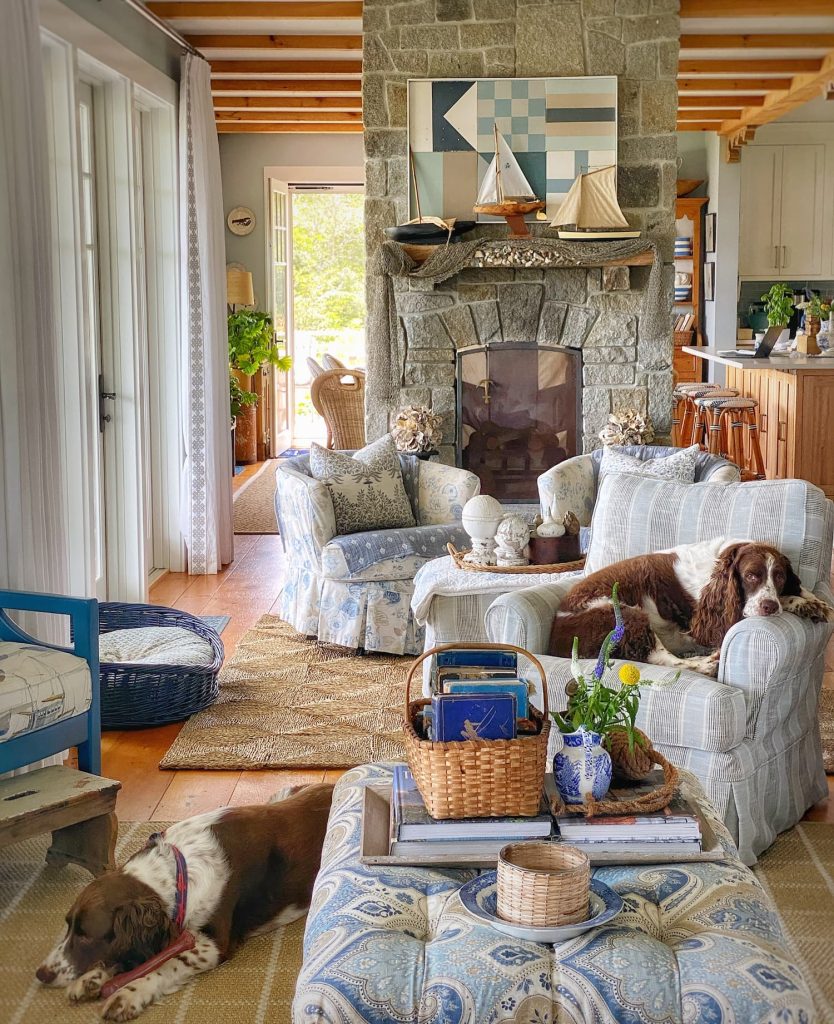
In last week’s blog post I wrote about how I swap out my wool area rugs for natural fiber jute, sisal, and seagrass in the summer.
They have that easy beach-house feel.
And, like a pair of blue jeans, they go with everything.
This week I am sharing everything you need to know about flat-weave jute, sisal, and seagrass natural fiber rugs.
How the fibers differ.
Care and maintenance.
Rugs I have in my home.
Plus, shopping links to some other favorites.
You can read about the other 7 design elements that for me embody classic coastal Maine summer cottage style in last week’s blog post 8 Elements of Classic Coastal Maine Summer Cottage Style
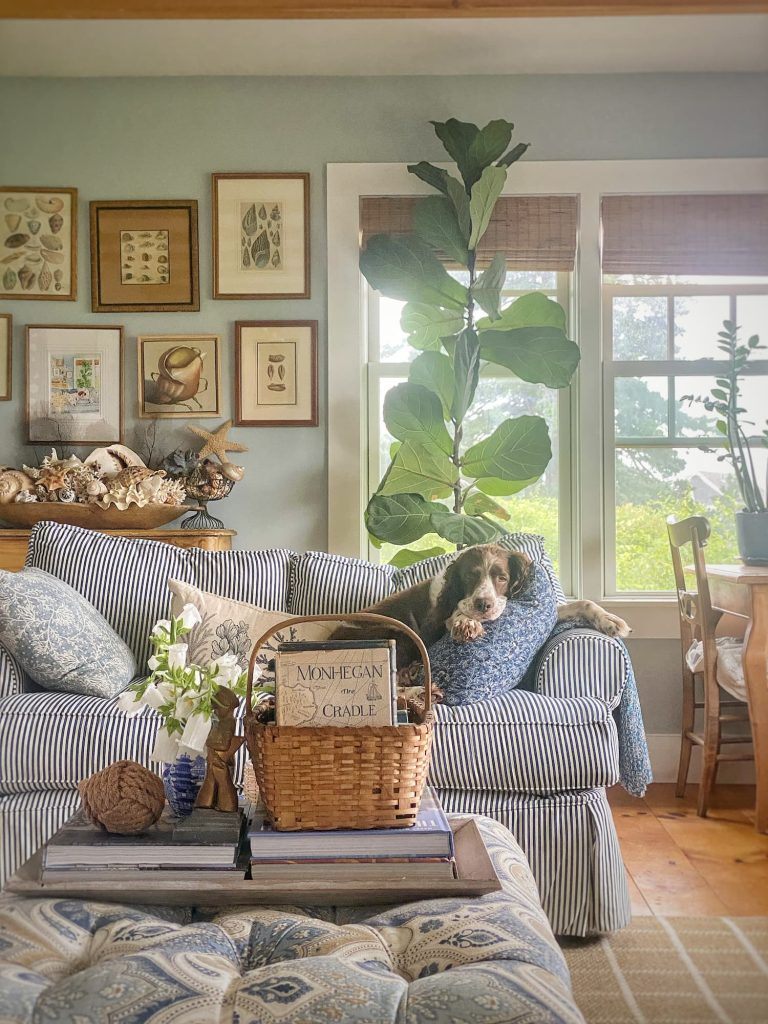
Different Fibers
Sisal, jute, and seagrass are the three most common fibers used to make rugs.
These fibers are all sustainable, as they come from fast-growing crops which can be harvested year-round.
Unlike plush wool pile or hooked cotton rugs, these natural fibers are woven or braided to create a flat rug or mat.
While rugs woven from sisal, jute, and seagrass all have a neutral organic feel, each fiber has its own characteristics.
Sisal
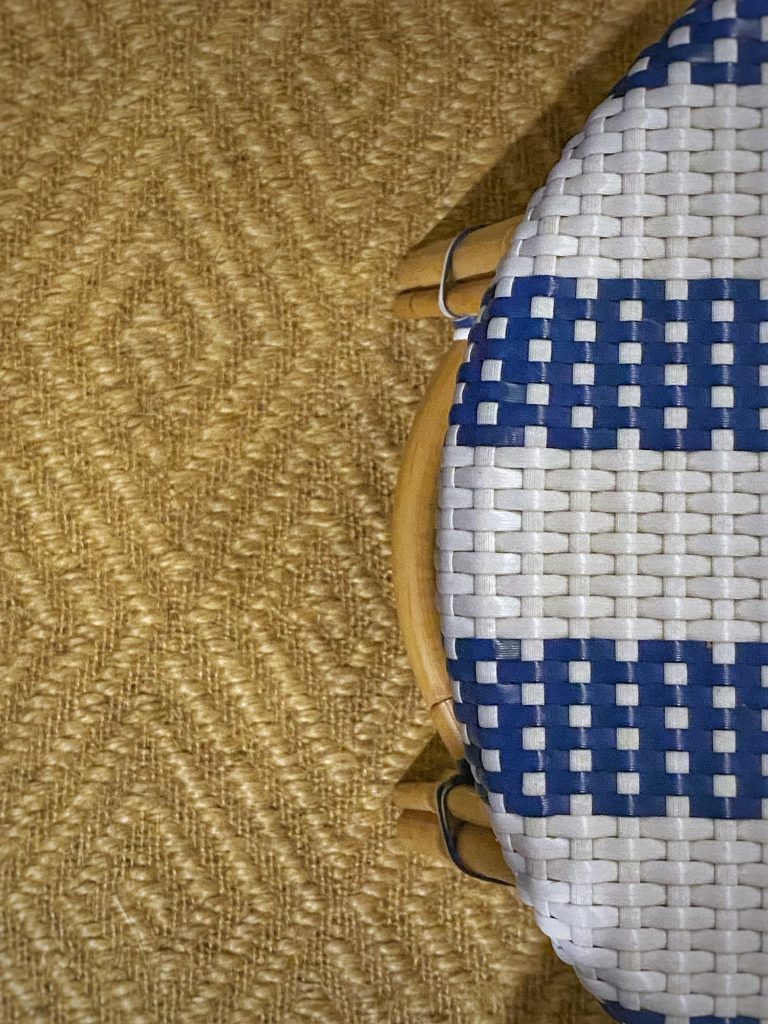
Probably the most popular rug fiber, sisal comes from the agave plant. (Who knew?!) Sisal fibers are stiff, making the rugs crafted from them strong and durable. They have a rough texture and a more tailored appearance. Sisal can be dyed.
Jute
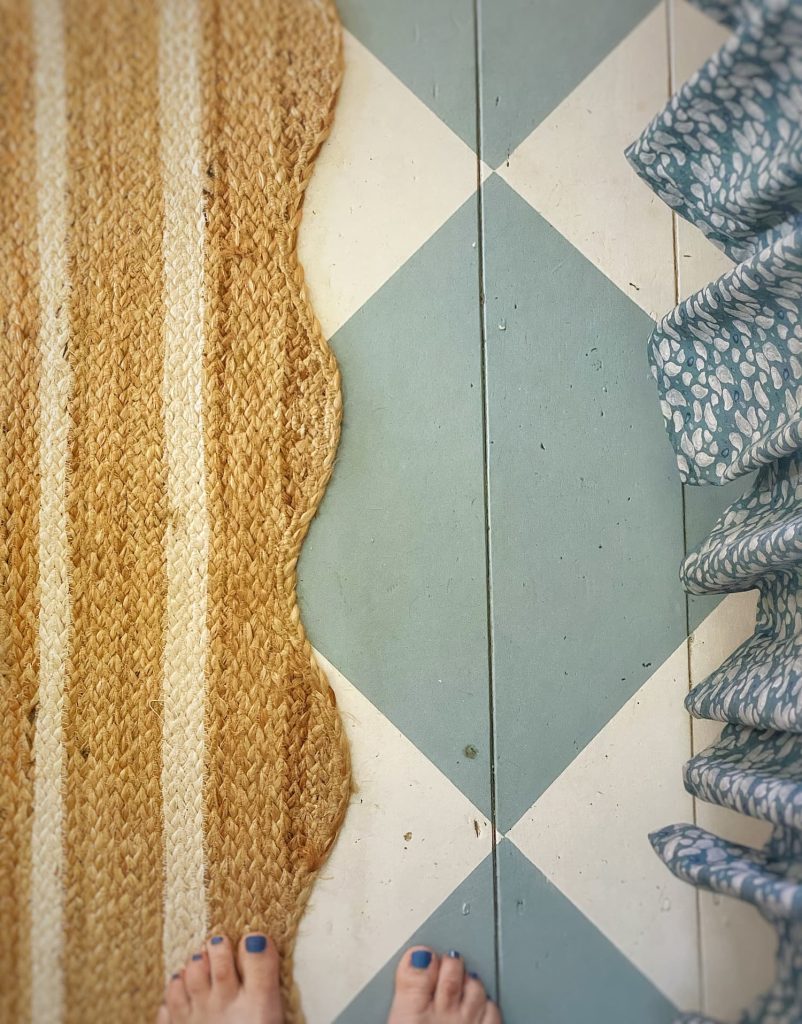
Jute is a long rough fiber derived from the stem and outer skin of the jute plant. The jute fibers are woven or braided to create fabrics and rugs. Jute is less durable than sisal and can have a tendency to shed. It has a softer feel, though, and a more relaxed look. Like sisal, jute fibers absorb dye well.
Seagrass
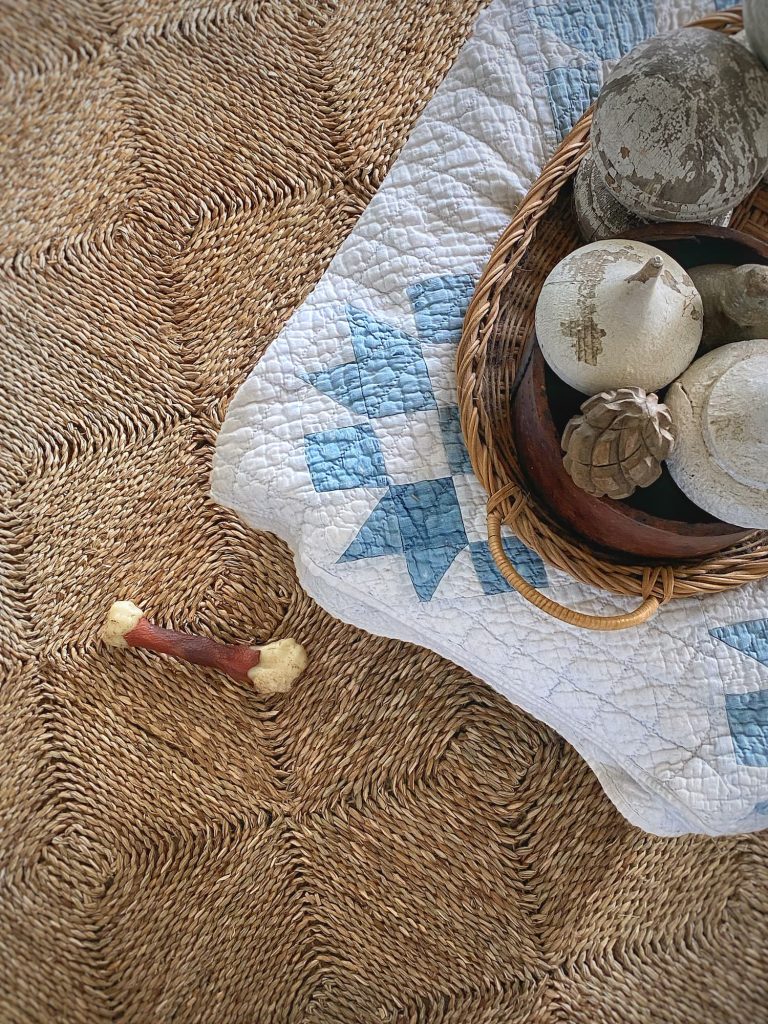
Seagrass fibers come from grass grown underwater, mostly in Asia’s wetlands. The salt in seawater gives seagrass a natural wax-like coating, making seagrass rugs highly durable and resistant to stains and spills. Seagrass fibers have a soft smooth texture and a slightly glossy finish. Seagrass fibers cannot be dyed. They start out green and weather to a golden brown. When your rug first arrives, it might have a sweet hay scent. These rugs are the least expensive option.
Other fibers
Hemp fibers are made from the stem of the hemp plants. Strong and durable, hemp rugs are similar to jute but often slightly softer.
Abaca comes from the leaf sheaf fibers of the abaca plant, a relative of the banana plant. Abaca rugs have a chunky textured surface and elegant sheen. They are soft underfoot like jute, and not as durable as sisal.
Coir is made from coconut husks. It is an incredibly durable fiber, but it has a very rough underfoot feel. Therefore it is most often used in commercial spaces such as stores and offices.
Artificial sisal rugs are made from synthetic fibers like polypropylene and recycled plastic bottles (PET), nylon carpets, and even fishing nets. These rugs can offer the look of natural fibers, with some advantages. They are durable, but still soft and comfortable. Many are stain and water resistant, making them ideal for messy or even outdoor areas. However you, won’t find that these artificial fibers have the natural differences that make each natural fiber rug unique.
Care and maintenance
Natural fiber sisal, jute, and seagrass rugs do not require any special care or maintenance.
Regular vacuuming will keep them clean and fresh. It is best not to use a rotating or “beater” brush, though, as loose fibers can get tangled in them.
As with all rugs, rotate periodically to ensure even wear and exposure to sunlight.
Use a rug pad to keep from shifting and reduce wear and tear.
Clean up spills immediately with water and mild soap as needed. I have found my woven natural fiber rugs to be very forgiving when it comes to spills and accidents.
The one word of caution is that these natural fibers are generally naturally absorbent, so should not be used in areas that are wet or damp. Use a synthetic woven fiber rug for outdoor spaces.
My Rugs
I have different rugs in all of the spaces that open to each other downstairs — dining area, living room, fireside seating area, and kitchen.
Each rugs has its own style, but they also work together.
They both unify and and define these spaces.
Here are the details!
Dining Room
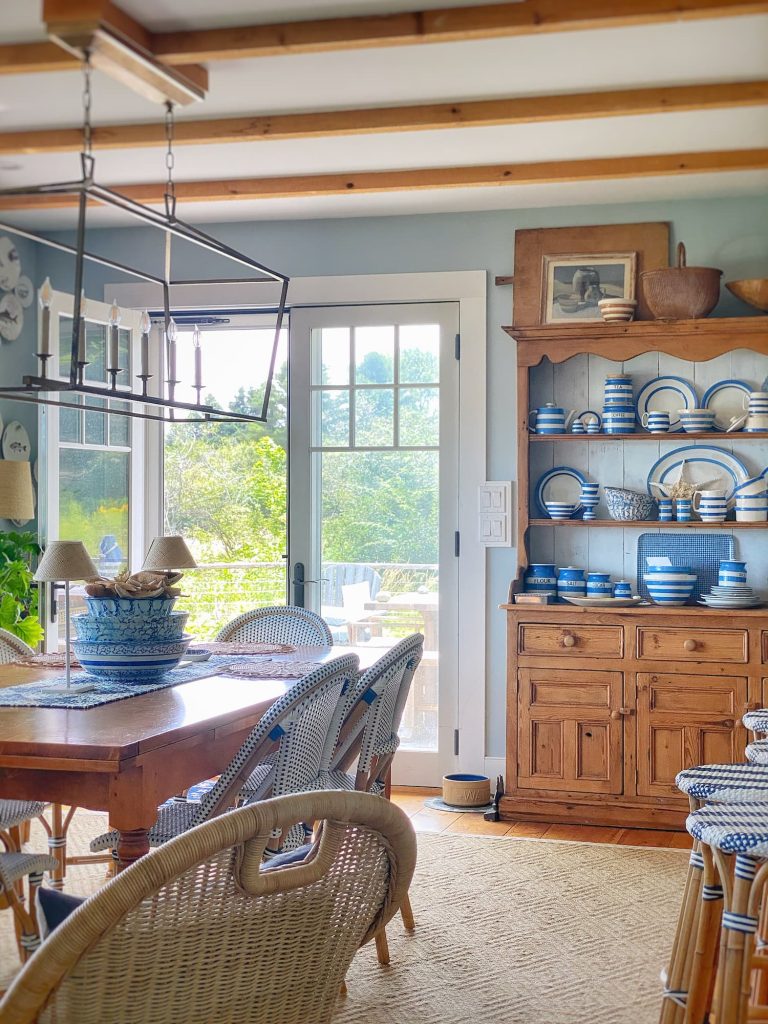
We moved the Stark Natura sisal rug in the dining room from Maryland with us. I bought it there at a local rug store.
With its subtle diamond weave, it is a classic, and has held up well over the last 15-plus years!
I don’t find it rough underfoot, but I probably wouldn’t stretch out and take a nap on it.
It has been extremely good with spills and pet stains.
Below I am linking a similar-look rug from Pottery Barn.
Living Room
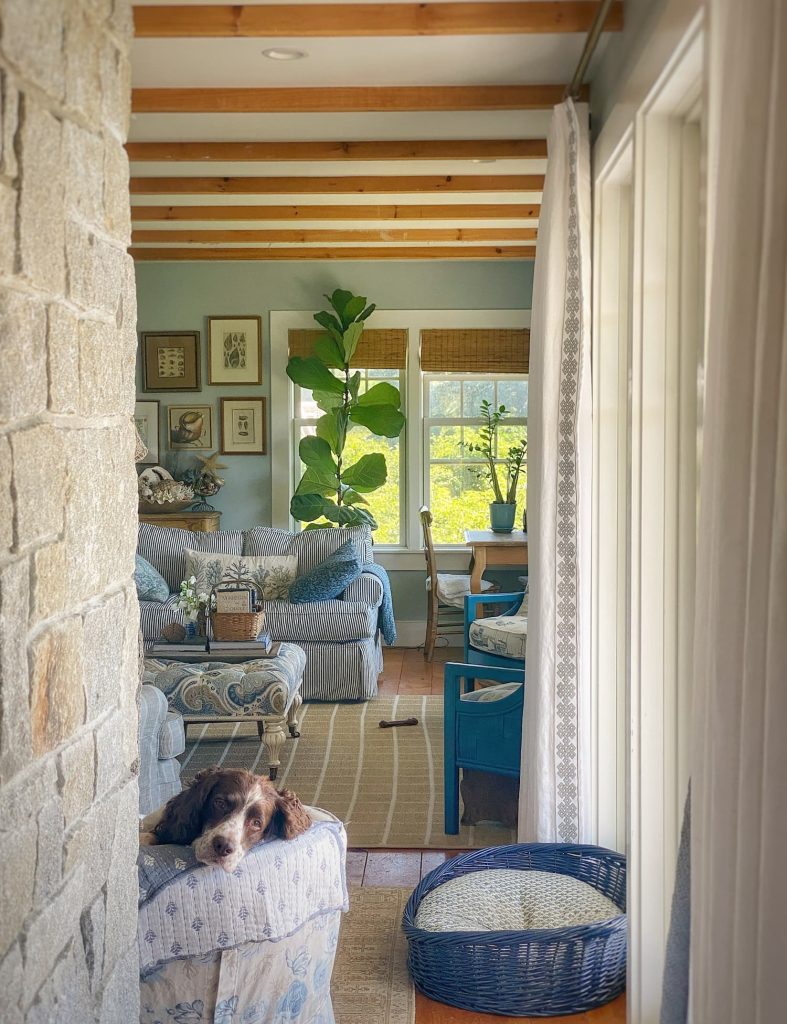
I love the check-patterned sisal and wool living room rug from Annie Selke.
Instead of swapping it out in the cooler months for a wool rug, I just layer a smaller vintage wool Turkish rug on top. The flat weave of sisal, jute, and seagrass rugs makes them perfect for layering. This is a great way to add extra texture, color, and pattern to a space.
Unfortunately Annie Selke no longer carries this rug.
This Stark Ovina rug looks to be almost identical in design (including the white wool accents), but the color is slightly different.
Below I am linking a rug from RugsUSA that has a similar look at a lower price point.
Kitchen
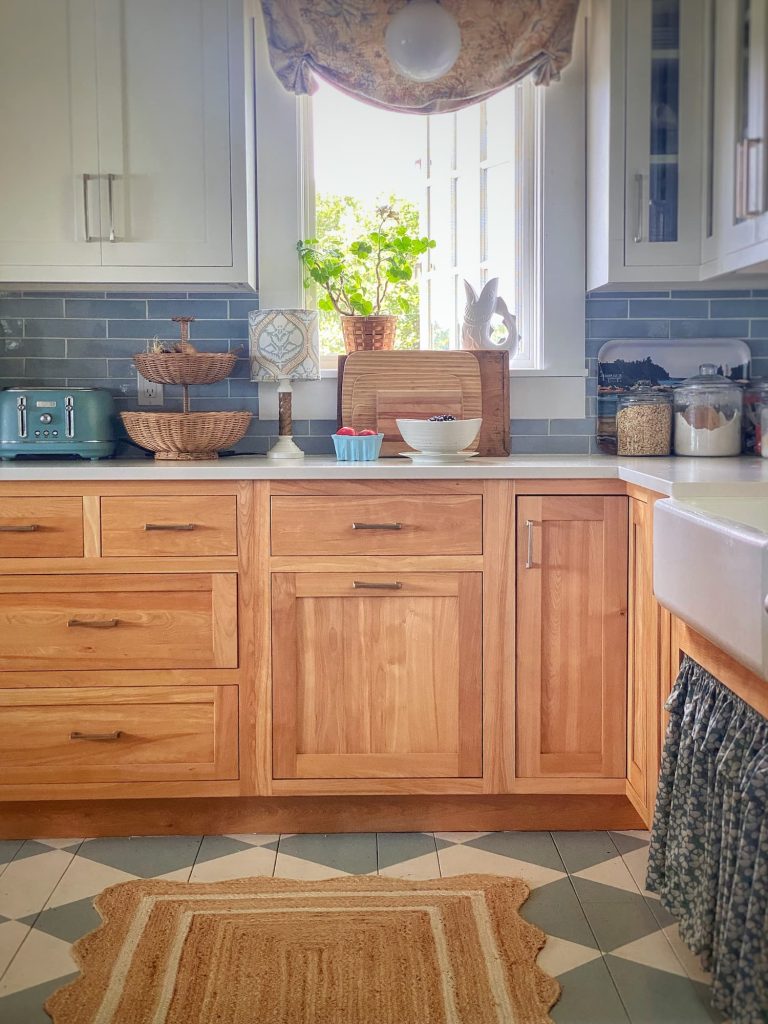
Last year I ordered a fun curvy-edged braided jute runner from Etsy for the kitchen.
It is reasonably priced and ships directly from India! It still amazes me that we have resources like this literally at our fingertips these days.
I haven’t spilled anything major on it yet, so I can’t attest to how resistant it is to stains.
But I love its easy breezy summer style and the texture and warmth it adds to the kitchen. It is the perfect accent against the blue and white checkerboard-painted floors.
In researching for this post, I just noticed that Serena and Lily is selling what looks like this exact rug for almost four times the price! Buying directly from the manufacturer on Etsy also gives you more size options!
Link is below!
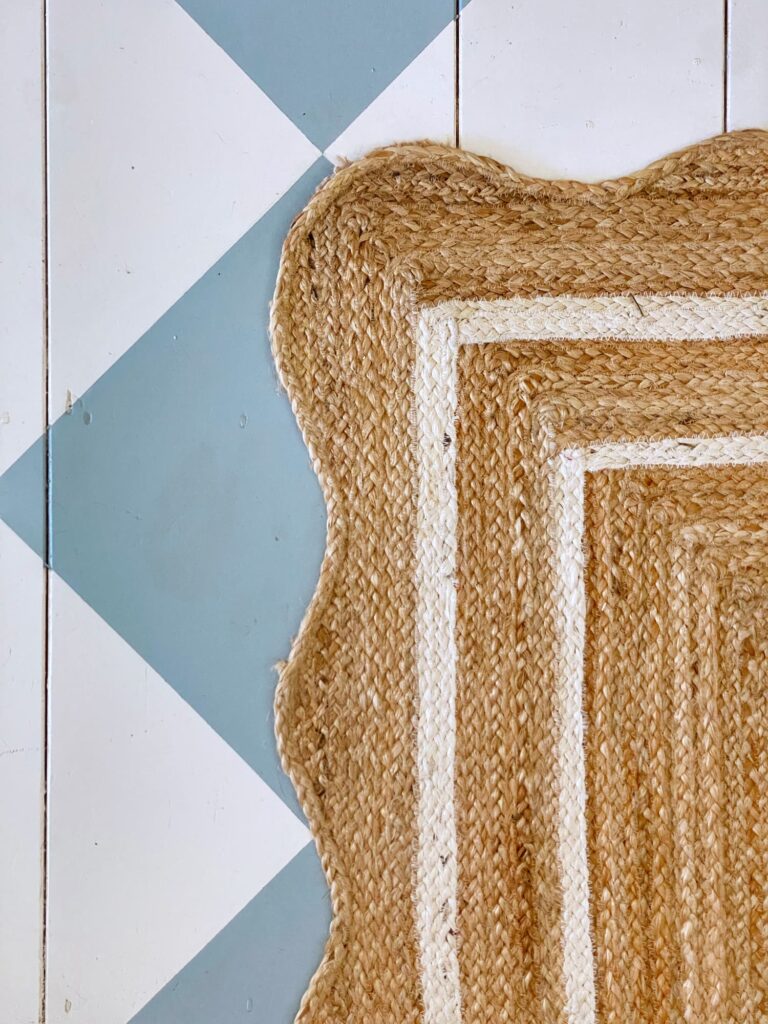
You can read all about my painted floor, including a step-by-step tutorial in my blog post: A Painted-Floor-Inspired Coastal Cottage Kitchen Refresh.
Fireside Seating Area
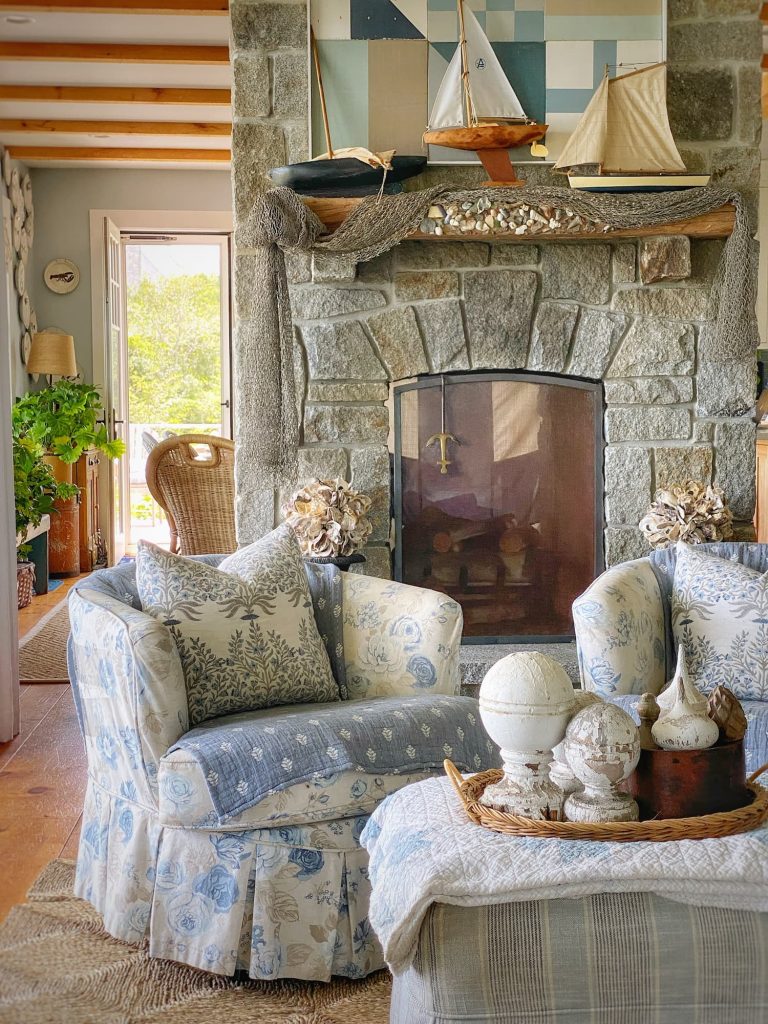
I have had my eye on seagrass mats like the Rush House Original Rug for years. Inspired by a Homeworthy episode, I finally bit the bullet and ordered one for the seating area next to the fireplace.
The great thing about these is that they are made in 1-ft squares, and you can order additional squares and a sewing kit to attach the squares to your rug. So you can create your own custom-sized rug.
Rush House has a “seconds sale” section and I decided to go with one of those because it was half price. My house isn’t perfect to begin with, so I figured it would be fine.
Variances in color and weave are inherent in natural fiber rugs like these. I think it adds to the beauty and makes each rug unique.
The only real issue I can see with the “seconds” rug I received is that the stitching on one of the squares has come loose. Since I am already attaching additional squares, I can fix this then. Easy!
I am in love with this mat and the amazing texture it adds to this sitting area. It has a loose chunky weave, and I can see that the stitching might not be super durable, but I will only be using it during the summer months, and I can always repair or replace squares.
You can also order these rugs from Chairish, but they are more expensive.
Linked below.
Update:
I have a confession to make.
Last week when I posted pictures of my Rush House mat here, I had not sewed on the extra squares.
They were just resting on the floor, unattached. Oh, the things you can hide in a photo!
This week I finally got around to getting this job done.
And a job it was.
The sewing itself was not the issue. That was just a basic stitch.
I ordered the sewing kit from Rush House, which comes with jute twine (instead of thread) and a large needle. The problem was, the needle has a rounded tip, and I found it quite difficult to get through the four to six layers of sea grass fibers they recommend.
I ended up wearing rubber tips on my fingers to protect them and give me a better grip.
Still, after sewing together 14 squares and then attaching them to the rug, my fingertips are a little sore.
All that said, I love the rug.
Maybe even more than I did originally.
Getting up close and personal with it like I did, I became a bit obsessed with its amazing texture and unique character.
And even though it was work, I got a custom-size 7’x7′ rug for this space. Exactly what I needed. The wool rug I have is also a square, and they are not easy to find.
Also, even though Rush House recommends that you don’t add squares to their “seconds” rugs, because they can’t guarantee a match of fibers, my additional squares are absolutely fine.
For the character this rug adds to the space, I think it was totally worth the extra effort.
And I am sure my fingertips will feel better soon…
Shopping Links
For your convenience, I am linking rugs that are the same as or similar to those I have in my home.
I am also linking some other favorite sisal, jute, and seagrass flat-weave rugs.
I cannot vouch for the quality of those items I do not personally own.
If you purchase from these links, I will receive a variable commission at no extra charge to you. Thank you for supporting my blog!
Happy shopping!
This Week Into Next
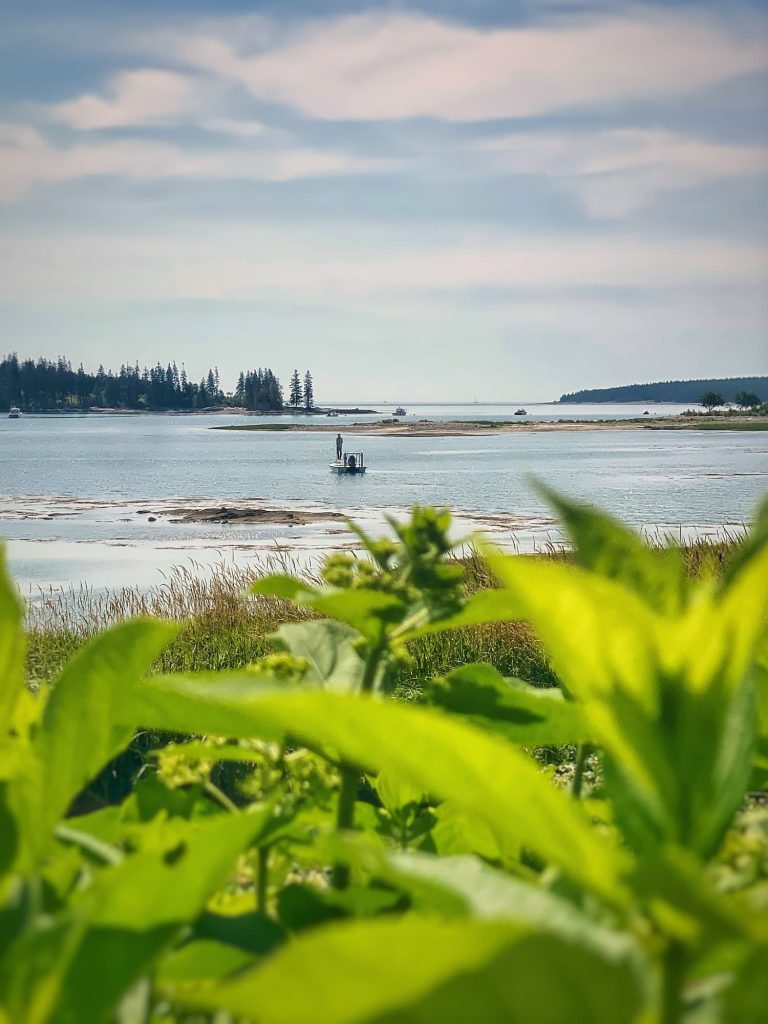
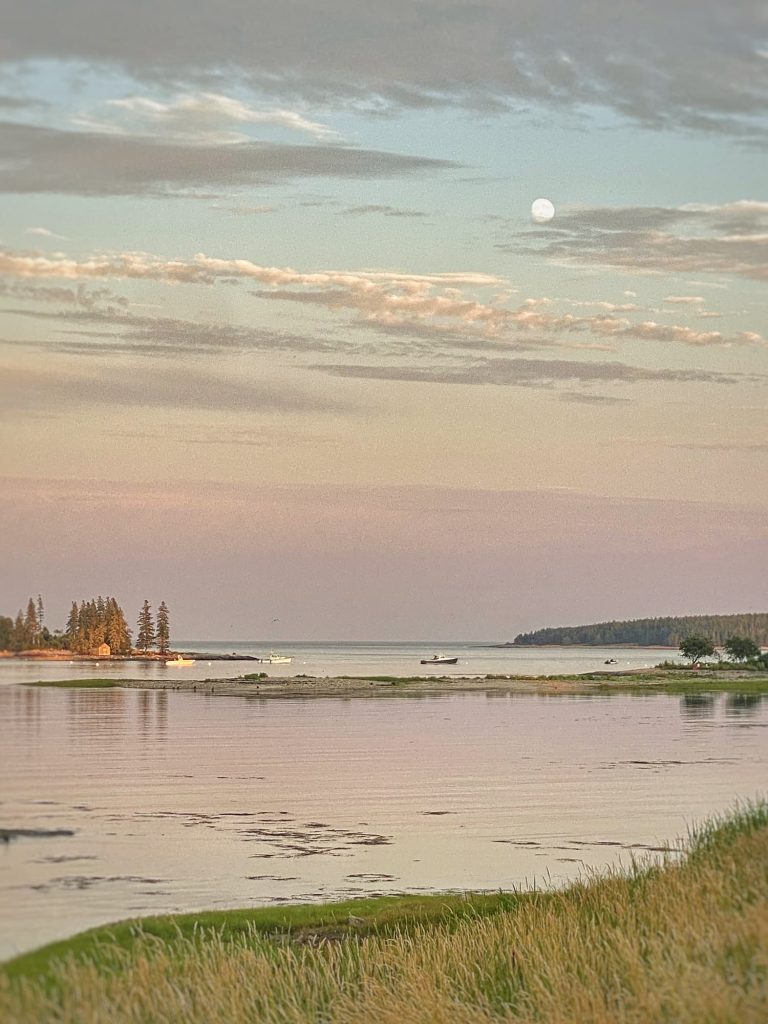
I had a busy and fun week with visiting friends!
We have been friends for years, and, even when we don’t see each other for a while, we still pick up right where we left off.
Friendships like these are so important.
Next week on the blog, I will be sharing all that we did, including the delicious meals we cooked together. Sneak preview: there was a visit to The Lost Kitchen, though not for dinner. We also took a boat ride. And of course you can’t have summer in Maine without lobster and blueberries…
For now, though, this blog post is already 24 hours late and even this extra day is nearing its end.
So it is time for me to wrap things up.
This week In Zoe’s Kitchen features Baked Farro with Summer Vegetables and Hearts of Palm Ceviche. Plus, Zoë demonstrates the best way to cut a melon!
Have a wonderful week, friends!


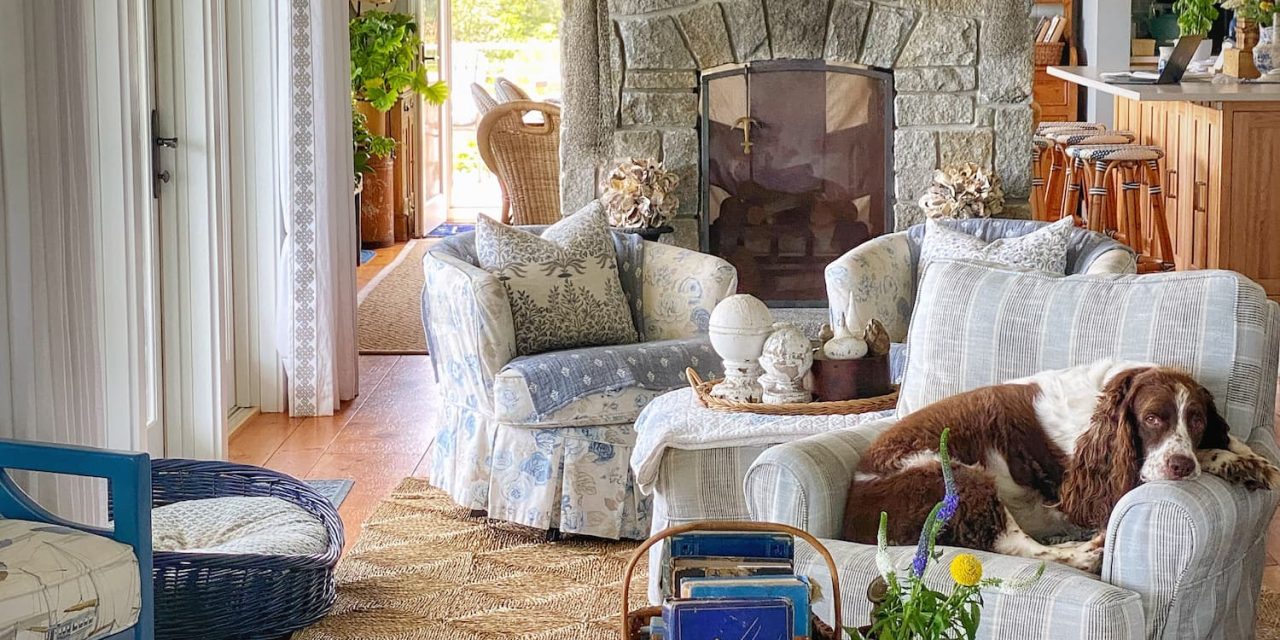

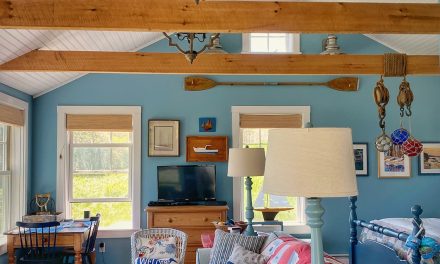
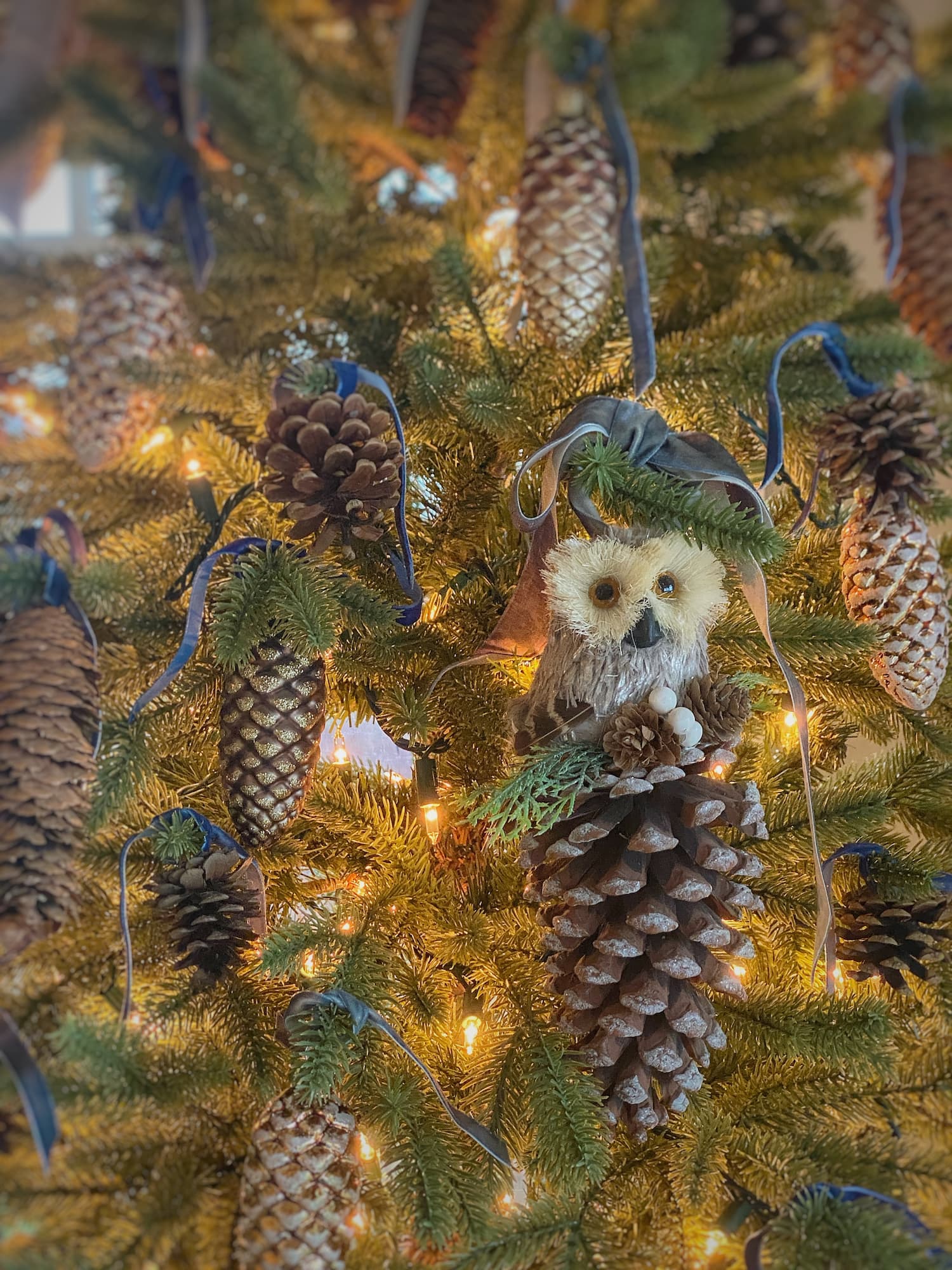
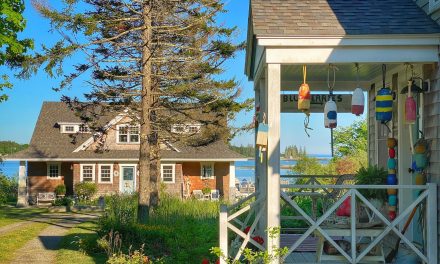

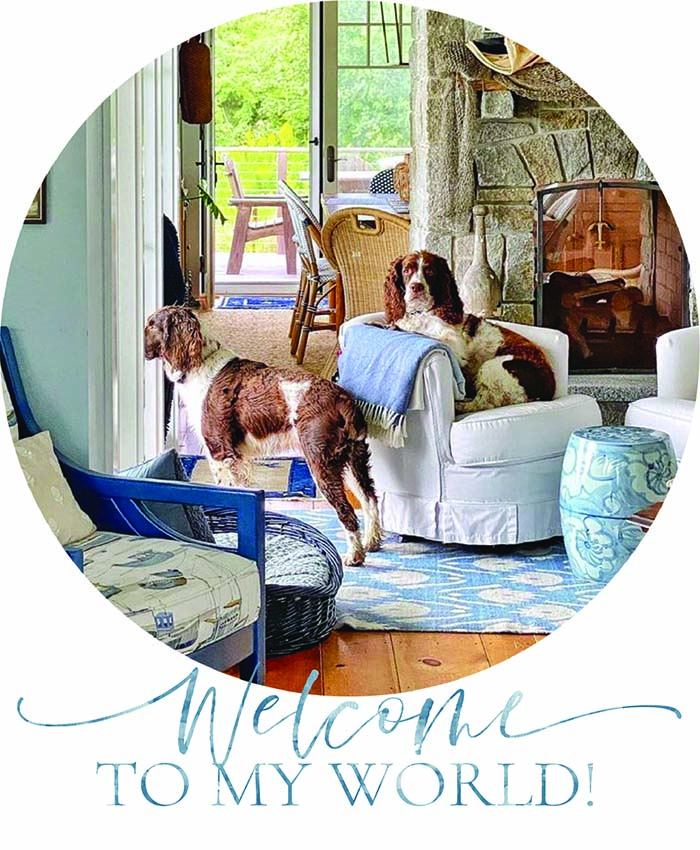
So enjoyed learning about the different types of natural fiber rugs. Now you have me looking around my house for places to slip a few in. I don’t have the fortitude you have to switch out seasonally, but I do like the layered look. Looking forward to reading about your trip to Freedom, and the yummy dishes you all cooked up.
Hi Julie — One of the things that I love about these kinds of rugs is how great they look layered! Do it!
So interesting to read this post today!
I was just looking at my beautiful jute rug, that I had custom cut for my square dining room. $$$$
It came with a rubberized backing, therefore not needing a rug pad. Bad idea.
It is about 10 years old and has completely fallen apart.
The backing has dry rotted and is now powder. The jute slides all around on the floor.
Plus every red wine stain is visible.
I do have some Stanton man-made sisal rugs in my foyer that are still looking great 15 years later.
Live and learn.
Thank you for these great sources!!
Hi Gray! I have a rubberized backing on the sisal rug in dining room and it has also started to deteriorate a bit too. I have had it for well over 10 years, though. Sisal is definitely more durable than jute, though. And while I haven’t spilled red wine on the rug yet, it has had plenty of other things spilled on it and none of them show. Maybe try a seagrass rug in the dining room since it is stain resistant!
Very useful information! I am in the market for a natural fiber rug.
Top picture: The pups are validating “that easy beach-house feel.” lol
Hi Lynda! I hope you find the perfect rug for your home! And yes, M&C definitely embody the laid-back lifestyle!
Bravo to you for do that hard work! If you are handy, as you are, it really is the best way to get exactly what you want. I would love to see a picture of your hands with the rubber tips. Mom would be proud of you.
Thanks, Liss! It turned into quite the job, but I think it was worth it!